Over the past decade we have seen a rapid shift from conventional machining to CNC machining. While CNC machined parts used to be required only in the most critical of applications earlier, they are now the mainstay, with even simple items like washers being churned out in this fashion, rather than depending on the perceived unpredictability of a manual system.
In the polymer space, while the shift to CNC has also been essential, there have been several complications that have arisen. We look at these here, in a bid to better understand the nuances of precision polymer machining and show that it is not always as straightforward as machining metals.
- Grades and varieties
The first thing to realize is that the term “polymer” is both broad and vague. As a company deep rooted in PTFE (Teflon) as our core product, our experience into other polymers taught us that the differences in each make the process of CNC machining that much more unique. Let’s take a look at how some of the high-performance plastics behave:
- PA 6/ PA 66 (Nylon or Polyamide) – Nylon machines easily, but due to its low melting point, the feed rate and RPM need to be optimized to ensure that burrs do not melt and stick to the part. Furthermore, the high moisture absorption of Nylon implies that coolants can rarely be used, as these would ‘swell’ the component, causing dimensional deviations
- UHMWPE – like nylons, UHMWPE also suffers from having a very low melting point. Furthermore, as UHMWPE needs to be compression moulded, the orientation of the molecules within the part are not always predictable. Achieving high tolerances on UHMWPE is not always possible as a result
- PEEK, PEI (Ultem), PI (Kapton) – these polymers are able to withstand high-temperatures and can therefore be run at higher speeds. However, due to the crystalline nature of the internal structures, the more stress applied during machining, the higher chance that the parts will crack. PEEK especially requires a special annealing process before it can be machined. In the event that multiple operations are required on a PEEK part, the part may be re-annealed between operations to ensure that the stress build up does not cause the part to crack later on.
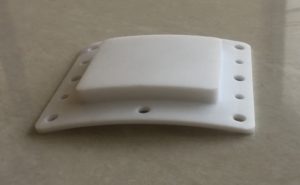
PTFE Radomes for Radar Applications
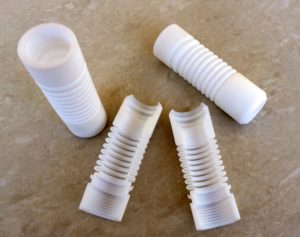
Bellows – Virgin PTFE
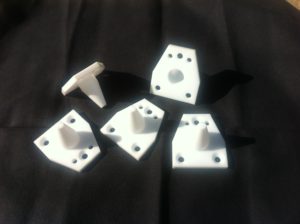
PTFE Radomes for High Precison Radar Applications
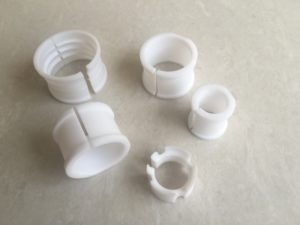
PTFE Bobbins – Virgin PTFE – Tolerance of 0.04mm
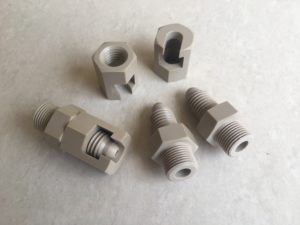
PEEK Adaptors for Aerospace
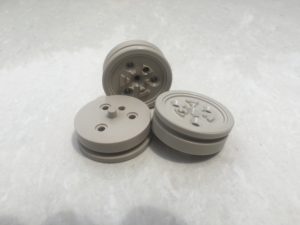
PEEK Piston – Tolerance of 0.025mm

PEEK Back Up Rings – 15% Carbon Filled
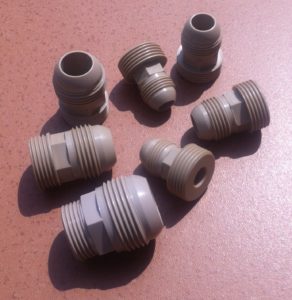
PEEK Adaptors for Aerospace
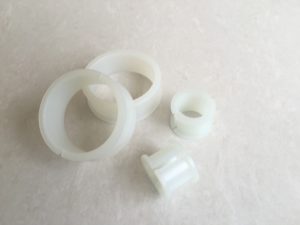
Nylon 66 Bobbins for Aerospace
The above examples are just a few of the peculiarities that each polymer brings. With polymers such as PTFE (Teflon), Delrin, PVDF (Kynar) and PVC, we have found the machining to be more straightforward. However, as the complexity of the part increases and the tolerances become tighter, the level of care needed increases, along with an increased need to understand the internal structure of the material.
- Tolerances and dimensions
We are often approached by other companies also involved in some form of polymer machining, requesting whether we have any excess demand that they can support us with. Our first question is always “what tolerances are you able to achieve”?”. The answer is usually between 0.05mm and 0.1mm.
From our perspective this is not adequate. While it is true that polymers do not lend themselves to the dimensional stability of metals (where tolerances of up to 1 micron are sometimes demanded), we have found that with the proper programming and handling, polymers can be machined to achieve a consistent tolerance of within 10-20 microns.
It is in this endeavour that we have put a lot of our focus and effort. It is also why having CNC machines is alone not enough to ensure the parts would be of the highest possible precision. Knowing the material and understanding how the part needs to be handled – both during and after the machining process is complete, is critical to be able to get that extra 30-40 microns in tolerance.
The other complexity on dimensions relates to the strength of the material. The longer the component, the tougher it becomes to attain close tolerances at the end – as the material starts to bend slightly, throwing the dimensions off. Again, knowing what the polymer is capable of and machining in a way that minimizes the deflection that the material would experience is key to ensuring a consistently machined component.
- Volumes
While polymer machined parts have certainly found their foothold across industries, the volumes remain tiny when compared with metals, or even some injection molded polymer components.
One of our concerns when shifting to CNC machining, was whether we could justify the expense against the low volumes of parts required. Keep in mind that apart from the machine cost itself, there are the added expenses of labour and special tooling.
Getting high-volume parts that also demand the criticality that we offer remains a crucial challenge.
Overall, the intricacies of polymer machining make it a rewarding experience. To be able to attain industry leading levels of tolerance across a whole range of polymers is something we are very proud of. So while CNC machining technologies certainly helped us move ahead, what set us apart was the ability to take the precision machining of polymers up a notch.
